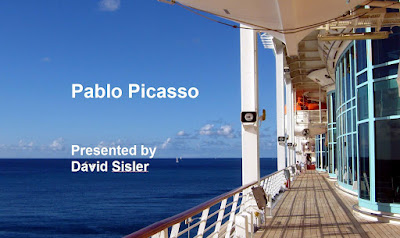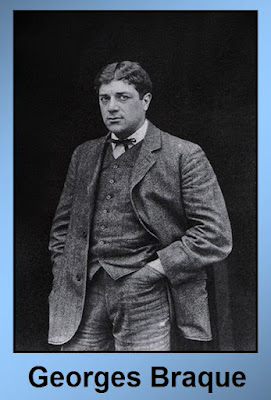March 18, 2022
In 1907, Picasso painted Les Demoiselles D’Avignon showing five women, one whose head looked like it was on backward. One critic said it was “the work of a madman.” Today it has been called the first modern 20th century painting. None of the five figures are conventionally feminine. They are angular and disjointed.
One of his friends who initially disliked the work was Georges Braque, but his subsequent collaboration with Picasso led to the Cubist revolution.
Picasso later admitted that the painting was modeled on Fernande Olivier. When he and Fernande broke up, Pablo said, “Her beauty held me, but I could not stand any of her little ways.”
Braque and Picasso worked together so closely that Pablo said, at times, they couldn’t tell who had painted which painting. Braque said he and Picasso were like mountain climbers attached to the same rope. Together, they were inventing a new style – Cubism. Pablo said, “I paint objects as I think them, not as I see them.”
Of all the important artwork that Pablo Picasso created in his life, it was cubism that made him famous. He said, “I knew we were painting strange things, but the world seemed a strange place to us.”
Soon Picasso and Braque were on to something new. Started by Braque, they began pasting things on to their pictures. If they wanted a newspaper to be shown, instead of painting it, they stuck on a real piece of newspaper. And the movement of collage began. Collage comes from the French for “to glue.” One of Picasso’s first collages was Still Life with Chair Caning. In it, he pasted a piece of oilcloth with a caning design. The border is made from rope. Braque did Bottle, Newspaper, Pipe and Glass.
Picasso painted in a new style. The forms were solid-looking, not jagged and broken cubist paintings. His painting, Three Women at the Spring, shows three figures in classical Greek style clothing. They have very rounded forms and thick legs. Picasso said painting the legs brought back childhood memories of crawling under the dinner table and seeing his aunts’ ankles.
At the same time he also painted Three Musicians in a very simplified cubist style. A clarinet player, a guitar player, and a singer holding sheets of music. The shapes and colors were brighter than in earlier works. He once said, “Cubism is not a reality you can take in your hand. It’s more like a perfume, in front of you, behind you, to the sides, the scent is everywhere but you don’t quite know where it comes from.”
In 1937 Picasso was in an 10 year long affair with Marie-Therese Walter, and was married to Olga Khokhlova, since 1918, and because of French law which required a 50-50 split, he never divorced her. Then in walked Dora Maar.
Marie-Thérèse and Dora met accidentally in Picasso’s studio. Asked about this years later, Picasso said that he had been quite happy with the situation and when they demanded that he choose between them, he told them that they would have to fight it out themselves, at which point the two women began to wrestle. He described it as one of his choicest memories.
In 1936 the Spanish Civil War broke out. In April, 1937, the town of Guernica was bombed by the Germans who were helping Franco. The bombs fell on market day. More than 1,600 people – men, women, and children – were killed. Almost 900 more were injured. There was no military reason for the attack.
Guernica was Picasso’s response to the murder of the innocent. With all his passion, he painted a huge 12 X 25 foot work. Guernica may be his most famous painting. It shows a screaming horse, a fallen soldier, a screaming woman on fire falling from a burning house, and a mother holding her dead baby. There’s a cutoff arm holding a sword and a severed head. It is a very strong and disturbing portrayal of the horrors of war.
Asked to explain the painting, Picasso said, “It isn’t up to the painter to define the symbols. Otherwise, it would be better if he wrote them out in so many words!”
During this time Picasso worked on amusing and childlike sculptures. They were made from things he found town. And so the pieces were called Found Art. At a junkyard, Picasso saw a bicycle seat and handlebars lying next to each other. He welded them together. Suddenly they looked exactly like a bull’s head.
For a sculpture of an ape, Picasso used a toy car for a face, a car spring for a tail, a jug for a body, and coffee cup handles for ears.
The story concludes next time with “Picasso and His Women.”
👉 Say it ain't so Pluggers:
🛐 Today’s close is from Praying with the Psalms, by Eugene H. Peterson.
“Truly the eye of the Lord is on those who fear him, on those who hope in his steadfast love” (Psalm 33:18).
Not only did the Lord make everything, he takes care of it. He did not create the world and then walk off and leave it; he watches over it wisely and lovingly. We are his creatures; we are also his children, for whom he provides faithfully.
Prayer: Your creative work, Almighty God, fills me with awe: such power and such magnificence! Your providence envelops me with hope: such care and such attention! Thank you for being everything to me in Jesus Christ. Amen.
-30-
















No comments:
Post a Comment